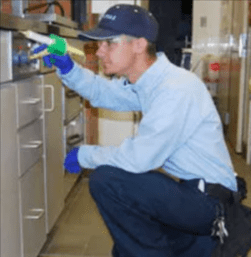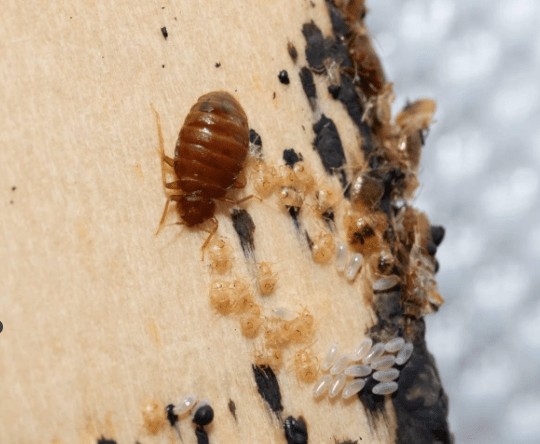Bed bugs are a common pest that can cause a lot of distress and discomfort.
One of the signs of a bed bug infestation is finding their shed skin or exoskeletons.
Bed bug shed skin, or exoskeletons, appear as translucent, light brown shells, often resembling the shape and size of a live bed bug.
These empty casings are typically found near hiding places such as mattress seams, headboards, and cracks in furniture.
Page Contents:
Do Bed Bugs Leave a Shell?
Yes, bed bugs do leave a shell behind. As bed bugs grow, they go through a process called molting, where they shed their outer exoskeleton. This is necessary for them to grow, as their hard exoskeleton does not expand.
Bed bugs typically go through 5 molts before reaching adulthood, leaving behind five shells, or exoskeletons, during their development.
These shed skins are often one of the first signs of a bed bug infestation.
They are usually found in the same places where bed bugs hide, such as in the seams of mattresses, box springs, bed frames, and other furniture.
What Does it Mean if You Find a Bed Bug Exoskeleton?
Finding a bed bug exoskeleton is a clear sign that bed bugs are present in your home.
The presence of these shed skins indicates that bed bugs are actively feeding and growing, which means they are breeding and potentially increasing in number.
If you find an exoskeleton, it is important to take immediate action to address the infestation. Bed bugs reproduce quickly, and a small problem can escalate into a significant infestation if not dealt with promptly.
You should inspect your living area thoroughly, focusing on areas where bed bugs are known to hide, and consider contacting a pest control professional for assistance.
What if I Found a Dead Bed Bug But No Bites?
Finding a dead bed bug but not experiencing any bites can be puzzling.
There are a few possible explanations for this:
1. Early Infestation: You might have discovered the infestation early before the bed bugs have had a chance to bite you.
2. Alternative Food Source: Bed bugs can survive for several months without feeding. The dead bug you found may have been one that was unable to find a host to feed on.
3. Bite Reaction: Not everyone reacts to bed bug bites in the same way. Some people do not show any visible signs of being bitten, even though they are being fed on by bed bugs.
Regardless of the reason, finding a dead bed bug is still a sign that there are likely more bed bugs present. It is important to conduct a thorough inspection and take preventive measures to ensure that any remaining bed bugs are eradicated.
What Does a Dead Bed Bug Look Like?
A dead bed bug looks similar to a live one but with some noticeable differences.
1. Flattened Body: Dead bed bugs tend to have a more flattened appearance compared to live ones.
2. Color: While live bed bugs are usually reddish-brown, dead bed bugs often turn a darker brown or black color.
3. Rigid Body: The body of a dead bed bug will be more rigid and less flexible than that of a live one.
4. Location: Dead bed bugs are often found in areas where they hide, such as mattress seams, bed frames, and cracks in furniture.
If you find a dead bed bug, it is crucial to continue searching for any signs of live bed bugs and take steps to address the infestation.
Prevention and Control
Preventing a bed bug infestation requires vigilance and regular inspection, especially if you have recently traveled or had guests in your home.
Wash bedding and clothing in hot water, vacuum regularly, and reduce clutter to minimize hiding places for bed bugs.
If you suspect an infestation, using mattress encasements can help trap and starve bed bugs, making it easier to detect their presence.
Professional pest control services are highly recommended for severe infestations, as they have the expertise and tools to effectively eliminate bed bugs from your home.
Dealing with an Infestation
If you confirm an infestation, it’s essential to take immediate and comprehensive action. Begin by isolating the affected area and thoroughly cleaning it.
Use a combination of vacuuming, steaming, and insecticides to target bed bugs at all stages of their life cycle. Enlist the help of a professional exterminator to ensure that all bed bugs are eradicated.
Follow-up treatments may be necessary to address any remaining bugs or newly hatched eggs. By staying proactive and vigilant, you can successfully manage and eliminate a bed bug infestation, ensuring a peaceful and pest-free home.
Summary
Bed bugs can be a persistent and challenging pest to deal with. Finding bed bug shed skin, exoskeletons, or dead bed bugs are all indicators of an infestation.
It is important to act quickly and thoroughly to address the problem to prevent it from worsening. Regular inspections, proper cleaning, and professional pest control can help keep your home bed bug-free.




